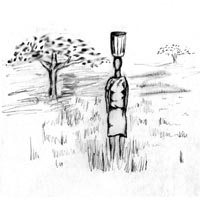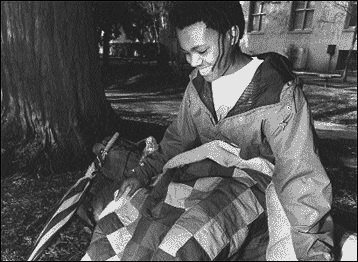|
Home
Project Evaluation
|
|||||||
4.1) How Well is the Water? In rural areas of Africa, drinking water is drawn from a well by hand-cranking a bucket attached to a lowering rope. The well is 20m from the cranking axle to the water below. To lower the bucket, the hand-crank is allowed to spin freely as the bucket drops. Make a graph of acceleration vs. time, velocity vs. time, and position vs. time for this motion, assuming the cranking arm is frictionless. Label the important values in the graph such as slope, beginning and ending points, etc. Once the bucket has filled, a woman begins to crank, uniformly increasing the speed of the bucket for five seconds until it’s going 0.5 m/s. She then cranks at this speed, until the bucket emerges above ground (1m left to crank). When the bucket emerges from ground she slows the bucket to a stop at a constant rate. Graph the trip of the bucket from the bottom of the well to the point where the bucket is at rest just below the cranking axle. Graph position, velocity, and acceleration vs. time. Label key transition points such as changes in acceleration and velocity on both axes. 4.2) Don’t be Late for School In rural southern Africa, some children walk two hours to and from school each day. At the same time, they are also responsible for morning chores around the home such as sweeping the yard, washing the previous night’s dishes, and feeding the goats and the chickens. From time to time these chores take longer than expected and the children will be late to school if they walk, so they run part of the way or all of the way to school. A child walks at about 4 km/hr and at this rate she gets to school in 2 hours. If she only has 1.5 hours to get to school and can run at 6.4 km/hr, what is the minimum time that she will have to run to get to school on time if both walks and runs on her journey? 4.3) Hauling water in Southern Africa
Young women in rural Zimbabwe, a country in southern Africa, must haul water over long distances so they can cook food and wash clothes, keeping their families sustained. A woman, Tsitsi, lives near a well that is 1 km due west from her house. However, Tsitsi cannot walk directly to the well because there is a rock outcropping on this route. She can take two different paths. First, she can walk slightly north of west and then turn 30 degrees to her left, walking until she reaches the well. This path is rough and she can walk 3 km/hr to the well. On the way back, with approximately 11 liters(5 gallons) of water contained in the bucket balanced on her head, she can only walk 2 km/hr. The other path is to walk ½ km straight south on the road from her village, and then follow a well-beaten path straight to the well. On this smoother path she can walk 4.5 km/hr on the way and 2.3 km/hr on the way back. Tsitsi doesn’t like to go back and fourth on the same path, and she wants to minimize the time she carries water. Which path should she choose? How long will this trip take, including the 15 minutes she spends at the well filling her bucket and chatting with other women? 4.4) Quilting
Sarah sits down to finish a quilt, 8 blocks by 6 blocks that she has pieced together for her daughter. She has made a simple patchwork top out of sky blue and yellow cotton blocks that are 25cm square. Now she wants to appliqué a ribbon on top of the patchwork. She has some red and green ribbon left over from her Christmas sewing. She must sew the red ribbon on more slowly because it easily bunches up under the foot of the sewing machine; the top speed for red is 1 cm/second. On the other hand, if she chooses green, she can sew it on at 2cm/second. She’ll sew the ribbon on a continuous path, starting in the bottom right hand corner of the quilt (0,0), going straight up 8 squares to (0,8), and then following the path (-3,4), (-6,8), (-6,0), (-3,4), (0,0). The sewing machine can change speed at a rate of 1cm/s2, and she must slow to a stop and restart every time she has to change directions in her pattern. How long will it take her to sew on the red ribbon? The green ribbon? |
|||||||
Posted on 8/1/05 © 2000-2005 Physics For Everyone. All Rights Reserved. |
|||||||

